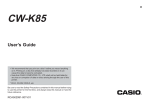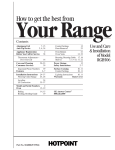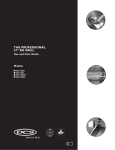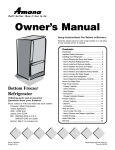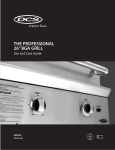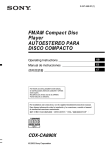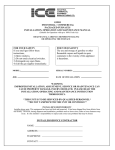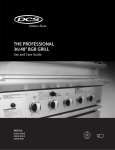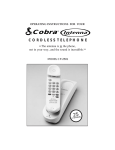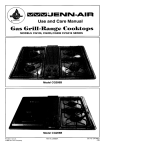Download Midco F400B-33 Specifications
Transcript
INSTALLATION AND
SERVICE INSTRUCTIONS
ECONOMITE MODELS
400-33 AND F400-33
Gas Conversion Burners
In the United States, Installation must conform with local codes
or, in the absence of local codes, with Installation of
the
National Fuel Gas Code, ANSI Z223.1-1992, or latest edition
available from American National Standard
Institute. Further
reference should be made to the recommendation of your
fuel supplier.
In Canada, Installation must conform with local codes or, in the
absence of local codes, with Installation Codes for
Gas
Burning Appliances and Equipment, CGA
Standard
CAN/CGA 1B-149.1 or 2. When the conversion burner is used
on a Forced Air Central Furnace, the two
yellow and black
warning labels in the literature envelope shall be attached in
accordance with Installation Code, CGA Standard CAN/CGA
1-B149, Clause 5.4.4.4. Further reference should be made to
the recommendation of your fuel suppler.
WARNING: Additions, changes, conversions, and service
must be performed by an authorized MIDCO representative,
service agency, or the fuel supplier.
Use only MIDCO
specified and approved parts.
INSTALLER: Inform and demonstrate to the
user
the
correct
operation
and
maintenance
of
the
gas
utilization
equipment. Inform the
user of the
hazards of storing flammable
liquids and
vapors in the vicinity of this gas utilization
equipment and remove such
hazards. Affix
this manual and associated
literature
adjacent to the conversion burner.
CODE
COMPLIANCE
IS
THE
SOLE
RESPONSIBILITY OF THE INSTALLER.
USER: Retain this manual for future reference.
If
other
than
routine
service
or
maintenance as described in this manual and
associated literature is required,
contact
a qualified service agency. DO NOT ATTEMPT
REPAIRS. An inadvertent service error could
result in a dangerous condition.
WARNING: If the information in these
instructions is not followed exactly, a fire
or explosion may result, causing property
damage, personal injury or death.
¥ Do not store or use gasoline or other
flammable vapors and liquids in the
vicinity of this or any other appliance.
WHAT TO DO IF YOU SMELL GAS:
¥ Do not try to light any appliance.
¥ Do not touch any electrical switch;
do not use any phone in the building.
¥ Immediately phone your gas supplier from
another building. Follow the gas supplierÕs
instructions.
¥ If you cannot reach your gas supplier call
the fire department.
Installation and service must be performed
by a qualified installer, service agency or
the gas supplier.
BURNER
MODEL
BILL OF MATÕL
NUMBER
DATE
CODE
WIRING
DIAGRAM
FOR SERVICE CONTACT:
name
address
phone
SAFETY INFORMATION TERMS. The following terms are used to identify hazards, safety precautions or special notations
and have standard meanings throughout this manual. They are printed in all capital letters using a bold typeface as shown below,
and preceded by the exclamation mark symbol:
DANGER: Identifies the most serious hazards which will result in severe personal injury or death.
WARNING: Signifies hazards that could result in personal injury or death.
CAUTION: Identifies unsafe practices which would result in minor personal injury or product and property damage.
MIDCO International Inc.
4140 WEST VICTORIA STREET ¥ CHICAGO, ILLINOIS 60646 ¥ (773) 604-8700 FAX: (773) 604-4070 ¥ http://www.midco-intl.com
797
PRINTED IN U.S.A.
8449-84
system, clothes dryer and/or fireplace is installed in the
building, provisions must be made for an outside air supply
near the heating appliance area. Install permanently open
grilles sized at not less than one square inch free area per
4,000 BTU of burner input. When ventilating through horizontal ducts, grilles should be sized at not less than one
square inch free area per 2,000 BTU of burner input. In
any case, the minimum dimension of rectangular air ducts
shall not be less than 3 inches.
■ In Canada, for detailed ventilation requirements, refer to
standard CAN 1-B149.1 or .2 and/or local codes.
SPECIFICATIONS1
The ECONOMITE Models 400-33 and F400-33 conversion burners with intermittent spark ignited pilot are
adaptable to most gas utilization equipment, including
gravity and forced circulation furnaces and boilers. They
are particularly recommended for firing horizontal or
downdraft equipment since they need no draft to maintain a pilot. Power burner design makes them perfectly
suited for oil burner replacement, including rooftop
and industrial applications
AIR DELIVERY (Approximate Air Delivery at Zero Draft)
400-33........................................................85 SCFM2
F400-33....................................................146 SCFM2
FIRING RATE (NATURAL or PROPANE)3
II
■ Clean the gas utilization equipment combustion chamber, heat exchanger interior, and flue connections. Remove all adhering tars, scale, dirt and soot. Inspect for actual or potential leaks.
■ Cement all joints, including those in the heating appliance base and around the door frames, to prevent leakage
into, or out of the combustion chamber.
■ The access or firing door should open easily to relieve
pressure. If positive latches exist, they should be modified
to permit easy opening; a spring loaded door holder is recommended.
■ On all boilers, make certain the pressure relief safety
valve is in good operating condition.
MAXIMUM 400-33......................................400 MBH4
MAXIMUM F400-33...................................700 MBH4
MINIMUM 400-33.......................................185 MBH4
MINIMUM F400-33............................ÉÉ.300 MBH4
GAS PRESSURE REQUIRED
NATURAL......................................5.0" to 14.0" W.C.
PROPANE....................................11.0" to 14.0" W.C.
TUBE DIAMETER..........................................................4"
TUBE LENGTH..............................................................8"
RECOMMENDED COMBUSTION CHAMBER SIZE
400-33 AT MAX BTU/HR........................10" x 161/2"
F400-33 AT MAX BTU/HR.ÉÉÉÉÉÉ15" x 25"
STANDARD VOLTAGE.............120 Volts...........60 Cycle
FLAME SAFETY..........Electronic Flame Safety with Spark
III
Ignited Pilot and 100% Shut-Off.
TABLE1 Burner Specifications
1.
Standard burners are shipped as NATURAL gas models. A kit is
available for field conversion to PROPANE gas.
SCFM = Standard Cubic Feet / Minute.
2.
3. All Ratings Based on 1000 BTU/Cu. Ft. NATURAL, 2500
BTU./Cu.Ft. PROPANE at Sea Level. Derate burner for altitudes
over 2,000 feet by 4% for each 1,000 feet above sea level.
4.
1 MBH = 1,000 BTU/hr.
One gallon of fuel oil = 140,000 BTU.
PART 1 INSTALLATION
CAUTION: ECONOMITE Burners are not intended
for outdoor installation and must be protected from
excessive moisture. Provide adequate clearance for
service and proper operation.
I
PREPARATION OF THE GAS
UTILIZATION EQUIPMENT
VENTILATION
If the former automatic oil burner gave trouble-free operation, it is probable that the heating plant area has sufficient infiltration of air for combustion and dilution of flue
gases. Nevertheless, the area must be checked.
■ Open basement or utility areas of normal construction,
without storm windows or tight doors, will generally allow
sufficient air infiltration. However, if the heating plant is
located in a tight or separate room, ventilation to an open
area as described above will be required. Install two permanently open grilles, each sized on the basis of one
square inch free area per 1,000 BTU (but not less than
100 square inches) of the total input rating of all gas utilization equipment in the combined space. One grille
should be located within 12 inches of the ceiling, the other within 12 inches of the floor.
■ If the heating plant is located in an area of unusually
tight construction, or if an exhaust fan, kitchen ventilation
-2-
COMBUSTION CHAMBER
A combustion chamber liner is normally required to protect
non-heat transfer surfaces and to provide a radiant bed for
rapid heat transfer to the primary surfaces of the heat exchanger. In most cases the existing chamber liner can be
used, if in good condition.
■ In the case of wet base boilers, where the entire firing
chamber is comprised of heat exchange surfaces and no
chamber liner was provided for oil firing, a liner is usually
not required for the ECONOMITE. However, a liner or target wall may be necessary if the firing chamber is unusually short, in order to avoid excess flame contact on the heat
exchanger walls or flueways.
■ If a built up chamber liner is required, use 2,300¡F minimum insulating material.
■ The burner tube, or the stainless steel sleeve that is included with the burner, must be sealed air tight into the
combustion chamber opening with refractory material as
shown by Figures 1and 2. The sleeve is preferred as it is
designed to properly locate the end of the tube relative to
the inside wall of the combustion chamber, and to permit
burner removal without breaking the seal.
CAUTION: In no case should the burner tube be
allowed to extend into the chamber proper; it must be
set at least 1" short of the inside surface.
■ Special heat resistant alloy extension tubes and instructions are available for those applications where the burner
tube is too short to reach the combustion chamber (such
as old-fashioned gravity warm air furnace installations).
WARNING: BURNER CABINET MUST BE MOUNTED IN
ORIENTATION SHOWN IN FIGURES 1 AND 2. ANY OTHER
MOUNTINGS MAY CAUSE A DANGEROUS CONDITION, AND
WILL VOID BURNER WARRANTY AND AGENCY APPROVALS. NON-STANDARD ARRANGEMENTS MAY BE AVAILABLE FOR SOME MODELS-CONSULT FACTORY FOR DETAILS IF REQUIRED.
■ Before permanently setting the burner in place, check
that the main burner casting and pilot ports are free of foreign materials, and also that the spark electrode assembly
has not been damaged or displaced. See Figure 7.
FIGURE 1 Dry Base Boiler with Combustion Chamber
Liner (Warm Air Furnace Construction is Similar)
■ The Vent Connector shall be as short as possible.
The entire length shall be readily accessible for inspection, cleaning, and replacement.
■ The length of horizontal uninsulated Vent Connector
between chimney and a single gas utilization equipment
shall not exceed 75% of the the height of the chimney
above the connector, or 100% if the Vent Connector is
insulated.
■ The Vent Connector shall be installed so as to avoid
turns or other construction features which create excessive resistance to flow of vent gas. It shall be installed
without any dips or sags and shall slope upward at least
1/4" per foot.
■ A manually operated damper shall not be placed in
the Vent Connector or chimney of any gas utilization
equipment.
■ The Vent Connector shall be firmly attached to draft
hood outlets and flue collars. Joints between sections of
connector piping shall be fastened by sheet-metal
screws or other approved means. The Vent Connector
shall be supported for the design and weight of the material employed to maintain clearance and prevent physical
damage and separation of joints.
■ A draft hood or a barometric draft regulator shall be
installed in the same room or enclosure as the equipment ins such a manner as to prevent any difference in
the pressure between the hood or regulator and the
combustion air supply (see Figures 3 and 4). In no case
shall the relief opening of the draft hood or barometric
draft regulator be located at a point lower than the top of
the highest flue passage in the equipment.
■ Gas utilization equipment requiring controlled draft
may be equipped with a listed double acting barometric
draft regulator, If approved by local codes (see Figure 4).
■ A device which will automatically shut off gas to the
burner in the event of sustained backdraft is required. It
shall be of the listed manual reset type and installed and
adjusted by a qualified service technician in accordance
with the manufacturerÕs instructions.
■ Refer to gas utilization equipment manufacturer for
recommended vent connection requirements.
FIGURE 2 Wet Base Boiler with Unlined
Combustion Chamber
IV
CHIMNEY, VENT CONNECTOR AND
DRAFT CONTROL
WARNING: The chimney shall be inspected for
unsafe conditions such as deteriorated masonry and
excessive soot or other blockage or potential blockage. Installation must conform with local codes or in
the absence of local codes with NFPA , ANSI Z223.1
latest edition.
WARNING: The vent connector shall not be connected to a chimney already venting solid fuel burning equipment, an incinerator or an open fireplace.
■ The Vent Connector shall be made of noncombustible, corrosion resistant material capable of withstanding the vent gas temperature produced by the gas
utilization equipment and of sufficient thickness to withstand physical damage.
FIGURE 3
-3-
Recommended Locations forDraft Hoods
FIGURE 4 Location for Barometric Draft Regulators
Figure 3 and 4 : Copyright by the American Gas
Association. Used by permission of the copyright holder.
V
ELECTRICAL
CAUTION: Refer to separate wiring diagram included with each burner.
Installation wiring and grounding to the burner must conform to local codes, or, in their absence in the United
States to National Electric Code, ANSI/NFPA No. 70
latest edition; in Canada, to Canadian Electrical Code
Part 1, CSA Standard C22.1
■ Use copper wire not less than 14 gage for line voltage
wiring. Hook up to a dedicated line with an on-off disconnect switch and a minimum 10 Amp breaker.
■ The frame of the burner should be well grounded. Normally the piping and/or electric conduit will provide sufficient grounding. However, a ground lug is located in control box for positive grounding where insulated pipe
couplings are used or where any doubt exists regarding
grounding sufficiency.
■ Confirm that the polarity is correctÑhot wire to strip terminal L1, neutral L2Ñand that the neutral line is not subject to induced low voltage (check L2 to earth ground)
from other equipment, as that can cause the electronic
flame safeguard to malfunction.
■ Each installation must include suitable limit control(s).
Existing oil burner combination operating and limit controls are normally NOT SUITABLE for gas burner use.
■ Connect motors used on forced air furnace fans or boiler pumps to a combination limit control and switch.
CAUTION: Label all wires prior to disconnection
when servicing controls. Wiring errors can cause improper and dangerous operation. Verify proper operation after servicing.
VI
PIPING
CAUTION: The available gas pressure should be
within the limits shown in SPECIFICATIONS section.
Excessive pressure may damage electric valves, regulators and manual valves. If the supply pressure exceeds the 14.0"W.C. maximum, a suitable high pressure regulator must be installed ahead of the Main
Manual Shut-Off Valve shown in Figure 5.
■ The burner gas supply piping should branch off from
the main line as close to the gas meter as possible. Do
not connect to the bottom of a horizontal section. Use new
black pipe and malleable fittings free of cutting and
threading burrs or defects.
-4-
■ Provide a sediment trap, union and 1Ú8" pressure tap in
piping close to burner as shown in Figure 5.
■ Use pipe joint compound approved for use with Liquid
Petroleum Gases.
■ Piping must also comply with your local codes.
■ To obtain the maximum firing rate of 700 MBH, the
NATURAL gas supply piping must be sized to provide a
minimum of 5.0"W.C. pressure (11.0"W.C. PROPANE) to
the inlet of the main safety valve when the burner and all
other gas utilization equipment are on. The pilot regulator
can be mounted in any position, the main regulator
should be mounted upright and in a horizontal run of pipe.
■ If the burner piping must be rearranged because of
space limitation, be sure to carry out the general arrangement shown in Figure 5.
■ Run full size pipe or tubing from regulator vent openings to outside of building. Provide no traps in the vent
lines and terminate away from all doors and windows;
also make provisions for keeping rain and foreign objects
from entering the vent piping.
■ When the burner is installed in the vestibule of jacketed
equipment, it is recommended that the Safety Shut Off Valve(s) be left adjacent to the burner within the vestibule and the Main Manual Shut-Off Valve be installed
outside.
■ When high supply gas pressure is encountered, as in
the case in many industrial plants, the gas line size can be
reduced to allow for a greater pressure drop; however, the
size must be sufficient to deliver burner rating pressure.
CAUTION: High gas pressure supply lines require
the proper pressure reducing regulators. Install two
separate high pressure regulators of the Tight ShutOff type upstream of the low pressure regulators. One
sized for main gas input, and one suitable for the minimum flow regulating capacity of the pilot.
■ The high pressure regulators may be substituted for the
low pressure regulators. If high pressure regulators are
used as substitutes, they must be adjustable down to a
minimum of 2.0"W.C. outlet pressure for the pilot and
5.0"W.C. for the main gas. If they are additions they must
be adjustable down to the maximum burner inlet pressure
rating (14.0"W.C.)
DANGER: Explosion hazard.
Do not use oxygen for pressure testing.
An explosion could occur during initial start up.
CAUTION: Because it is difficult to accurately
control pressure during supply pipe leak testing, it is
recommended that all low pressure (14.0"W.C. max.)
components, both main and pilot, be disconnected
during testing. Exposing low pressure regulators and
valves, including manual valves, to pressures over 1/2
PSIG (14.0"W.C.) will cause damage and void all
warranties.
■ When the gas supply line is about to be put into service
it must be rested to insure that it is gas tight. Use air or
inert gas under pressure and test with soap and water or
other liquids to locate leaks.
■ Before gas is turned into the system, a check must be
made to see that there are no open fittings and to make
sure the burner main and pilot manual valves are closed.
■ After checking above, purge the gas line up to the
burner inlet. Purging the air from the gas supply line at
this step will expedite the first light-off.
PIPE
SIZE
3Ú4
(400-33 only)
1
1 1Ú4
1
1 Ú2
2
TYPE
OF
GAS
Natural
Propane
Natural
Propane
Natural
Propane
Natural
Propane
Natural
APPROXIMATE CAPACITY-MBH
LENGTH OF PIPE
10
275
400
500
700
700
20
300
350
550
700
700
40
200
250
375
500
700
700
60
NATURAL GAS
100
200
300
400
625
600
700
700
225
300
475
450
700
700
VII
BURNER
MANIFOLD
DRILL INPUT PRESSURE
DRILL
INPUT
PRESSURE
SIZE
MBH1
W.C.2
SIZE
MBH1
W.C.2
11/32
(.343)
185
300
1.5"
3.5"
#21(.159)
185
250
25/64
(.390)
300
400
2.0"
3.5"
#15(.180)
#9(.196)
#3(.213)
7/163
(.437)
400
540
2.0"
4.0"
#1(.228)
17/64(.265)
1.85"
9/32(.281)
625
3.2"
19/64(.296)
700
300
350
400
10.0"
540
DATA IS APPROXIMATE AND BASED ON Ò0"
OVERFIRE PRESSURE AT SEA LEVEL
1. Input range of spud. Adjust the main regulator to
vary the manifold gas pressure and burner input
within the range shown for a specific spud drill size.
With PROPANE, do not exceed 11.0"W.C. under
any circumstances.
2. Approximate gas pressure at manifold gas pressure
tap.
3. Drill out 25Ú64 spare spud to 7Ú16.
TABLE 3: Spud Capacity and Preliminary Gas Settings.
MAIN GAS SPUD SELECTION
Burners are approved for use with NATURAL or
PROPANE gas and should be used only with the gas
specified on the rating plate.
■ The gas input should be set at the heating rate
determined by the building heat loss and/or heating plant
survey, but not exceeding the rated maximum input of
the gas utilization equipment or Economite burner.
■ Burners are shipped equipped for NATURAL gas; the
model 400 with a 11/32 drill spud installed, and the F400
with the spud removed. Compare the gas input required
with the spud capacities shown in the spud table and, if
necessary, install the spare spud (see Figure 7).
MANUAL
BALL VALVE
SPUD BURNER MANIFOLD
SPUD 540
REMOVED 700
CAUTION: Purge outside the building. Do not
purge into the gas utilization equipment combustion
chamber.
CAUTION: Do not exceed maximum or minimum
rated capacity of burner model as shown in Table 1.
Capacities shown are for a total pressure drop of
0.3"W.C. For 0.5"W.C. pressure drop, multiply capacity
shown by 1.3 For higher permissible pressure drops,
consult your utility.
TABLE 2: Schedule 40 NPT Pipe-Capacity Chart
PROPANE GAS
SPUD
MANUAL PILOT VALVE
PILOT REGULATOR
PILOT TUBING
BLOWER MOTOR
MAIN AIR
CONTROLLING SHUTTER
(COUNTER CLOCKWISE
TO OPEN)
MAIN REGULATOR
VENT
PILOT SOLENOID
MAIN
REGULATOR
FLAME
SAFEGUARD
CONTROL
SPARK GENERATOR
PRIMARY AIR ADJUSTMENT
PILOT TEST TAP
MAIN TEST TAP
DRIP
LEG
MAIN AND
REDUNDANT MAIN
GAS VALVES
BALL VALVE
TEST COCK
PILOT AND AIR TUBE
"PEEP" SIGHT
FIGURE 5 Piping Connections
-5-
VIII INITIAL START UP AND ADJUSTMENT
WARNING: Ignition is automatic. Make spark
observations into combustion chamber only with
Main and Pilot Manual Shut-Off Valves closed. Confirm that gas utilization equipment does not contain
any accumulated gases. Purge as described below.
CAUTION: Cover plates, guards, and enclosures
must be maintained in place at all times except during maintenance and service.
1. Check the piping and valves for gas leaks. Apply
a weak liquid soap solution to unions and joints with
the gas supply on. Leakage will be indicated by
the appearance of soap bubbles. Locate and
correct all gas leaks before proceeding.
WARNING: DO NOT USE OPEN FLAME
2. Make sure that the burner main and pilot gas lines
are completely purged of air. Do not purge into the
combustion chamber.
3. Make sure the burner power switch is off, Main and
Pilot Manual Shut-Off Valves are closed, and motor
is free to rotate. Reset flame safeguard and all limit
controls.
CAUTION: Make sure that the capacity range
of the installed spud and the combustion airshutter setting are suitable for the gas utilization
equipment. Refer to Section VII and Table 2.
4. Turn on the burner power switch, and allow motor to
run through the pre-purge and ignition cycle. Check
the blower wheel for proper rotation. After a short
run, the flame safeguard will lock out, stopping
the motor. Wait one minute, then reset flame
safeguard.
5. Turn on pilot manual shut-off valve. With Main
Manual Shut-Off Valve still closed, turn on main line
switch. Motor will start. When pre-purge period has
elapsed, flame safeguard will energize pilot solenoid
valve and ignition transformer. Quickly observe pilot
flame.When flamerod senses pilot flame, the
flame safeguard will energize the main valves.
No main flame will occur due to closed Main
Manual Shut-Off Valve. Set pilot pressure to
achieve the largest stable blue flame with a base
that burns firmly within the pilot tip. The best
operating pressure is usually about 3.5"W.C.
Natural (2.25"W.C. Propane). If pilot fails to light see
sections IX and XI.
6. Test for ignition and stability. Cycle the burner
several times with both open and closed air shutter.
Ignition and flame safeguard response will be
prompt with a good flame. Check flame following the
instructions provided by the flame safeguard
manufacturer.
WARNING: Repeated unsuccessful attempts to
light may result in accumulated gases in gas utilization equipment and chimney. To prevent these gases from reaching an explosive level, periodically
purge the gas utilization equipment and chimney as
described above.
7. Check operation of the electronic flame detection
circuit by turning off the pilot manual valve with pilot
burning and Main Manual Shut-Off Valve still
closed. The circuit to the main automatic pilot valve
should be broken immediately.
8. Turn off line switch to stop the burner. Reset flame
safeguard. With On-Off burners, lock air shutter
-6-
wide open. On modulating burners, remove wires of
modulating controller from and "W" terminals on
the modulating motor and jumper terminals "R-B" to
drive input adjuster to high fire position when
energized. On 2-step burners, jumper terminals "34" on valve actuator valve will open to high fire
position when energized. main flame ignites. Slowly
continue opening the Main Manual Shut-Off Valve to
the wide open position when energized.
9. To make a preliminary setting of the burner input,
determine the manifold gas pressure required from
Table 3 and adjust the main gas pressure regulator
accordingly. See Section XI.
10. To determine the firing rate for NATURAL
gas, accurately time test dial for the number of
seconds for one revolution and use the following
formula. All other gas utilization equipment must
be off.
3600 x test dial size x BTU value
no. of seconds for one rev. test dial
= BTU/Hr.
Then divide by 1,000 for MBH value.
Example:
3600 x 1 x 1000 = 360,000 BTU/Hr. = 360 MBH
10
11. Adjust combustion air shutter to provide a quiet, soft
blue flame with well defined orange and yellow tips
for NATURAL gas or with well defined yellow tips for
PROPANE gas.
12. The primary air adjustment which affects the flame
length has been set wide open for average
conditions. Decrease the primary air if a longer,
softer flame is desired.
13. Check the operation of the burner; start and stop it
several times with the thermostat or operating
control.
14. With the burner running, check the operation of all
limit and associated controls.
15. PERFORM
THE
FOLLOWING
FINAL
ADJUSTMENTS for combustion and flue gas
temperatures. Take the flue gas samples and
temperature immediately ahead of the draft control.
A. The flue gas temperature should be above
325¡F but not exceeding 550¡F. Excessive flue
gas temperatures will result in low efficiencies.
Low flue gas temperature may cause excessive
condensation. Reset gas input if necessary to
adjust stack temperature.
B. Make the final setting of the combustion air
shutter by checking the flue gases with an
ORSAT or similar combustion testing instrument.
The carbon monoxide content should conform to
local codes, or, in their absence to the level
specified in the Unites States or Canadian
Standard referenced on the front cover of this
manual. The carbon dioxide content should
be approximately 9.5% for NATURAL and
12.1% for PROPANE, or within the limits
prescribed by local codes.
16. Check the draft control to make sure there is no
spillage of flue products into the room.
After the initial start-up procedure, the following steps
can be followed for routine start-up and shut-down on a
seasonal or extended basis.
BURNER START UP
1.
2.
3.
4.
5.
6.
7.
8.
Make sure burner power switch is off.
Set controller to call for heat.
Open firing door.
Open Main and Pilot Manual Shut-Off Valves.
Reset flame safeguard.
Turn on burner power switch.
Close firing door after main flame ignites.
Reset controller to desired setting.
BURNER SHUT DOWN
1.
2.
3.
Turn off burner power switch.
Close Main Manual Shut-Off Valves.
Close pilot manual Shut-Off Valves.
PART 2 SERVICE
DANGER: Do not tamper with the unit or controls. If trouble occurs contact the installing contractor, service agency, or fuel supplier. See front
cover.
WARNING: Be sure that the main and pilot
manual Shut-Off Valves are closed and the burner
power supply is turned off before removing any
parts for service.
CAUTION: Cover plates, guards, and enclosures
must be maintained in place at all times except during maintenance and service.
IX
pressures are 3.5"W.C. NATURAL gas and 2.25"W.C.
PROPANE.
■ Some conditions which may require a change from
the normal setting include: extremely long tubing connections between the regulator and pilot solenoid, high
negative or positive combustion chamber pressure, actual air shutter setting and altitude extremes.
■ Do not subject the pilot to an inlet pressure over
14.0"W.C. See section VI PIPING for high pressure gas.
Note that the standard pilot pressure regulator is not a
tight shut-off and, during standby, the outlet pressure will
build up to the full inlet pressure.
■ The spark rod is located on the center line of the pilot
and is positioned so the high tension voltage will arc to
the inside of the center port of the retention plate (see
Figure 7).
■ The flame rod must be positioned as shown in Figure
7 so that the flame safeguard will detect a proper flame.
Note that it is slightly above the centerline of the pilot.
■ Both the spark and flame rods are currently carrying
conductors and, along with their connecting wires, must
be kept free of contact with conductive metal parts of the
burner. Rod insulators and wire insulator should be
clean, dry and free of cracks.
■ Rods are made from heat resistant alloys and can be
expected to have a long service life. They should be routinely inspected, however, for corrosion or loss of metal.
■ The pilot air tube must be kept free of kinks or inside
obstructions and its inlet end must be positioned per Figure 7, otherwise air flow could be reduced and adversely affect the pilot flame.
PILOT
The pilot is of the premix, blast type. The full force of
blower air is brought into the mixing tube where the proper amount of gas is added through the pilot orifice. This
mixture is discharged through the pilot which contains a
perforated flame retention plate. The outer holes diverge to spray the mixture against the side wall of the pilot tip to provide flame retention. The mixture through
the center port provides the flame that contacts the
flame detection rod and also ignites the main gas.
■ Surrounding the base of the pilot flame is a conical
shroud which protects the flame against extraneous air
currents and inhibits "blow-off" from an overly rich flame.
NOMINAL BTU/Cu. Ft. Hr.
NATURAL 1000ÑPROPANE 2500
PILOT GAS PRESSURE
APPROX.
ORIFICE CAPACITY
MODEL DIAMETER BTU/Hr.
400-33
DRILL #68
.031 DIA.
NATURAL
PROPANE
2500
2.5"-4.0"W.C. 2.25"-3.5"W.C
F400-33
DRILL #55
.052 DIA.
7000
TABLE 4: Pilot Specifications
CAUTION: Do not indiscriminately increase pilot
orifice size. Pilot troubles are rarely cured in this
manner and new troubles may be created.
■ The pilot gas orifice is the same size for both natural
and propane gas, consequently the gas pressure required for propane is lower than that required for natural
gas. Under normal conditions, with a slight negative
-7pressure in the combustion chamber, pilot operating
X
MOTOR, BLOWER INTERLOCK &
CENTRIFUGAL ACTUATOR
CAUTION: BEFORE SERVICING, mark with a
scribe line or measure position of combustion air
controlling shutter, so that it can be reset to its original position following servicing.
The blower, which is driven by the motor, functions to
supply a constant and dependable source of combustion
air. A centrifugal actuator is mounted on the blower
wheel and, through the interlock switch, proves blower
operation on every run.
■ Cleaning of the blower wheel is usually the only service required. Need for cleaning is indicated if the air
cage assembly shows an accumulation of dust and lint,
or if the character of the flame indicates a deficiency of
air. Motor cooling air vents if present should also be
cleaned at this time.
■ The blower side plate, motor and wheel are removed
as an assembly. Disconnect the motor wires, and conduit then remove the side plate screws.
■ Unless the blower wheel location has been disturbed,
a replacement switch and bracket assembly will assume
the correct position when mounted. Confirmation of the
correct assembly can be made by measurement and
test.
■ A) With the switch assembly unmounted, insert a
probe through the blower opening and push actuator
disk inward as far as it will go. Mark the depth of insertion on the probe and measure. Measure the portion of
the switch plunger (unrestrained) protruding past the
bracket arms. The probe insertion measurement should
exceed the switch stem protrusion by at least 1Ú16".
place the entire valve. After replacement check for leakage. If the valve is removed from the piping do not use
the operator assembly as a lever to turn valve. Apply
wrench on the valve body flat adjacent to pipe being removed.
■ B) Insert the switch stem through the blower opening
until it just contacts the actuator disk. Then push in slowly. The switch should "click" and the actuator spring
should compress approximately 1Ú8" before the bracket
arms are seated. If conditions A and B are not met reset
switch location in the mounting bracket.
■ In both cases above check the results with an electrical continuity test. The circuit across terminals C and NC
should be open when the blower is idle and closed when
the blower is running.
■ When shaft location of blower wheel is disturbed, reassemble with a 1Ú16" clearance as shown in Figure 6.
XI
XIII OPTIONAL MOTORIZED MAIN
AUTOMATIC VALVE
(Employed with Redundant Solenoid Valve.)
■ Motorized Main On-Off, 2-Step, and Full Modulating
Valves, are available on special order. The redundant
and solenoid valve may be omitted if the motorized valve
includes optional "Proof of Closure Switch".
■ When the actuator is energized, hydraulic fluid is
pumped from a reservoir to a metal bellows. The bellows
transfers the resulting pressure through the drive stem to
open the valve. A separate spring return drive arm
operates the blower shutter.
■ For general service, the valve should be checked for
operation. The valve actuator may be removed from the
valve body, however, do not disassemble actuator; if
malfunction occurs, replace entire actuator assembly.
The valve body is also not field reparable. If leakage is
detected the entire valve body must be replaced.
GAS PRESSURE REGULATOR
The main gas pressure regulator is used to automatically
reduce and maintain constant gas pressure at the burner. The regulator furnished as standard is suitable for a
maximum inlet pressure of 14.0"W.C. The springs installed provides for an adjustable outlet pressure range
of 2.0" to 5.0"W.C. and are factory set for 3.0"W.C. This
regulator is not of the Òtight shut-offÓ type and, consequently, when the burner is on standby, the outlet pressure will build up to equal the full inlet line pressure. Outlet pressure settings must be checked while the main
gas is flowing.
■ To adjust the outlet pressure, remove the seal cap for
access to the adjusting screw. Turning the screw clockwise will increase outlet pressure, counter-clockwise will
decrease outlet pressure.
■ When the gas supply pressure is over 14.0"W.C.,
special regulators are required. See Section VI.
■ The vent in the upper diaphragm case normally
breathes only air, but must be connected to the outside
air to prevent escape of gas into the building in case of a
ruptured diaphragm. The vent line must be of sufficient
diameter, otherwise the restriction of air flow may cause
sluggish opening of the regulator. The effect can be
checked by comparing main flame start-up time with the
vent line connected and disconnected. The vent must
never be connected to the burner combustion chamber.
■ When the regulator is to be installed, or replaced take
care not to crush the body casting. Apply wrench only to
the heavy body section adjacent to the pipe thread.
XIV
FLAME SAFEGUARD
WARNING: Explosion hazard. Do not use any
electronic device if it gets wet. It can malfunction
and cause serious injury or death. Replace any
device that has been wet.
■ Standard F400-33 and 400-33 burners are equipped
with a Honeywell RM7895 microprocessor based burner
control, employing a flame rectification system of flame
detection. Burner construction for special codes and/or
insurance requirements such as Factory Mutual or
Industrial Risk Insurers (IRI) may require alternate
controls. (Refer to Section XV Special Equipment). A
safe start and run control sequence is provided with
instantaneous response to presence or loss of flame
signal. Flame failure response time is 3-seconds.; Pilot
Flame Establishing Period (PFEP) is field selectable
from 4 or 10-seconds. The RM7895 features a pre-purge
time (30-seconds for ON-OFF, 90-seconds for 2-Step or
Modulating burners), and a plug-in amplifier. An airflow
circuit is also field selectable to allow either lockout or
recycle upon loss of airflow. Five LEDÕs (light emitting
diodes) are provided to display sequence information.
Refer to the Honeywell RM7895 literature for detailed
operating information, configuration requirements,
testing, and service.
XII SOLENOID GAS SAFETY VALVES
(Main and Redundant Main; Standard Construction.)
When the valve operators are electrically energized the
plungers lift the valve disk off the valve seats, allowing
gas to flow. When the current is broken the valves close.
They will normally require no service. However, dirt or
foreign matter on the valve seats could cause leakage.
If leakage is detected or if the operator malfunctions re-
FIGURE 6 Motor, Blower, and Interlock Assembly
-8-
■ After the ignition trials, and with the presence of flame,
the main valve is energized. ("MAIN" LED will be lit.) If a
flame-out occurs, the RM7895 will lockout or recycle
within 3-seconds, depending on "jumper" configuration.
Refer to Honeywell literature for proper configuration.
INITIATE ("POWER" LED is lit).
■ The RM7895 enters the INITIATE sequence when it is
powered. The INITIATE sequence lasts for ten seconds
unless the voltage or frequency tolerances are not met
(refer to Honeywell RM7895 literature for criteria). When
tolerances are met, the INITIATE sequence will restart. If
the conditions not corrected and the hold condition exists
for four minutes, the RM7895 will lock-out. Causes for
hold conditions in the INITIATE sequence are in the
Honeywell RM7895 literature.
RUN
■ The RM7895 is now in RUN mode and will remain in
run mode until the controller input opens, indicating that
the call for heat has been satisfied or a limit has opened.
Once this occurs the RM7895 will sequence back to the
STANDBY mode.
Notes: 1. During STANDBY and during RM7895
sequencing the "POWER" LED will blink
every four seconds. This is normal.
2. The "ALARM" LED will be lit in the event of
any flame failure.
3. To maintain proper operation of this device
in MUST be electrically grounded. Refer to
Honeywell RM7895 literature for criteria.
STANDBY ("POWER" LED is lit).
■ The RM7895 is idle in this state of sequencing. When
the burner switch, limits, operating limit controls, and all
microprocessor monitored circuits are in the correct state
for the RM7895 to continue, sequencing will advance to
PREPURGE.
PREPURGE ("POWER" LED is lit).
■ The RM7895 in this application features a prepurge
time of 30-seconds for ON-OFF, 90-seconds for 2-Step
or Modulating burners.
■ Once the STANDBY sequence has a "CALL FOR
HEAT" input, normal start-up prepurge will be initiated.
A. The blower motor is powered to start the prepurge
sequence.
B. The airflow interlock switch must close in
ten seconds of prepurge or within the specified
purge card timing. Otherwise a recycle to the
beginning of prepurge or lockout will occur,
depending on how the airflow switch selectable
jumper is configured. Refer to Honeywell
RM7895 literature for configuration requirements.
XV SPECIAL EQUIPMENT (OEM VERSIONS)
Special equipment, either factory or field installed,
can cause variations in the procedures and descriptions
given in this manual. Generally, any burner ordered with
special factory installed equipment will be supplied with
the appropriate wiring diagram and related instruction
manuals from the special equipment manufacturer
Consult these manuals to identify any differences in
construction, operation, and testing. Field installed
special equipment is the responsibility of the installing
contractor.
IGNITION TRIAL
1. PILOT FLAME ESTABLISHING PERIOD (PFEP)
A. The pilot valve and spark generator are
energized.
B. Flame must be proven by the end of the 4 or
10-second PFEP to allow the sequence to
continue. If flame is not proven by the end of
PFEP, a safety shutdown occurs.
2. MAIN FLAME ESTABLISHING PERIOD (MFEP)
FIGURE 7 General Assembly
-9-
TROUBLE CHART
MAKE SURE THE THERMOSTAT AND OPERATING CONTROLS ARE CALLING FOR HEAT.
CAUTION: If a test indicates an electrical component may be defective, before
replacing it, make sure that its associated wiring is not at fault.
1.
MOTOR WILL NOT RUN.
A. No current.
B. Defective or misadjusted limit or thermostat.
C. Flame safeguard control on lockout.
D. Defective flame safeguard control.
E. Motor overload out.
F. Defective motor.
2.
MOTOR RUNS, PILOT WILL NOT LIGHT, FLAME
SAFEGUARD LOCKS OUT.
A. Air in pilot gas line.
B. Low gas pressure.
C. Clogged pilot orifice.
D. Pilot regulator misadjusted or defective.
E. Defective spark electrode or spark generator.
F. Defective high tension wire.
G. Wrong pilot orifice.
H. Defective pilot valve.
I. Pilot air tube clogged.
J. Incorrect spark gap.
K. Pilot regulator vent clogged.
L. False flame signal; flame safeguard
control.
M. Defective flame safeguard.
3.
4.
C.
D.
E.
F.
G.
H.
MOTOR RUNS, PILOT WILL NOT LIGHT, FLAME
SAFEGUARD REMAINS "SET."
A. Defective centrifugal actuator.
B. Defective blower interlock switch.
C. Slow motor.
D. Defective purge timer.
E. False flame signal.
F. Defective flame safeguard.
PILOT LIGHTS, NO MAIN
LOCKS
OUT.
A. Poor pilot flame adjustment.
B. Clogged pilot air tube.
FLAME,
Defective flame rod or wire.
Flame rod mislocated.
Spark interference.
Pilot regulator vent clogged.
Defective plug-in amplifier.
Defective flame safeguard.
5.
PILOT LIGHTS, NO MAIN FLAME,
REMAINS "SET."
A. Defective main gas valve.
B. Closed leak test cock.
C. Low gas pressure.
D. Grossly misadjusted main gas and air.
E. Defective flame safeguard.
6.
SPASMODIC START.
A. Loose wiring.
B. Low gas pressure.
C. Poor pilot flame adjustment.
7.
SHORT FLAME.
A. Wrong main orifice.
B. Low gas pressure.
C. Air shutter misadjusted.
D. Main regulator misadjusted.
E. Test cock partially closed.
F. Main regulator vent clogged.
8.
LONG HAZY FLAME.
A. Wrong main orifice.
B. High gas pressure.
C. Dirty blower wheel.
D. Air shutter misadjusted.
E. Main regulator misadjusted.
9.
GAS FAILS TO SHUT OFF.
A. Dirt on valve seat(s).
B. Defective main valve(s).
RELAY
-10-
RELAY











